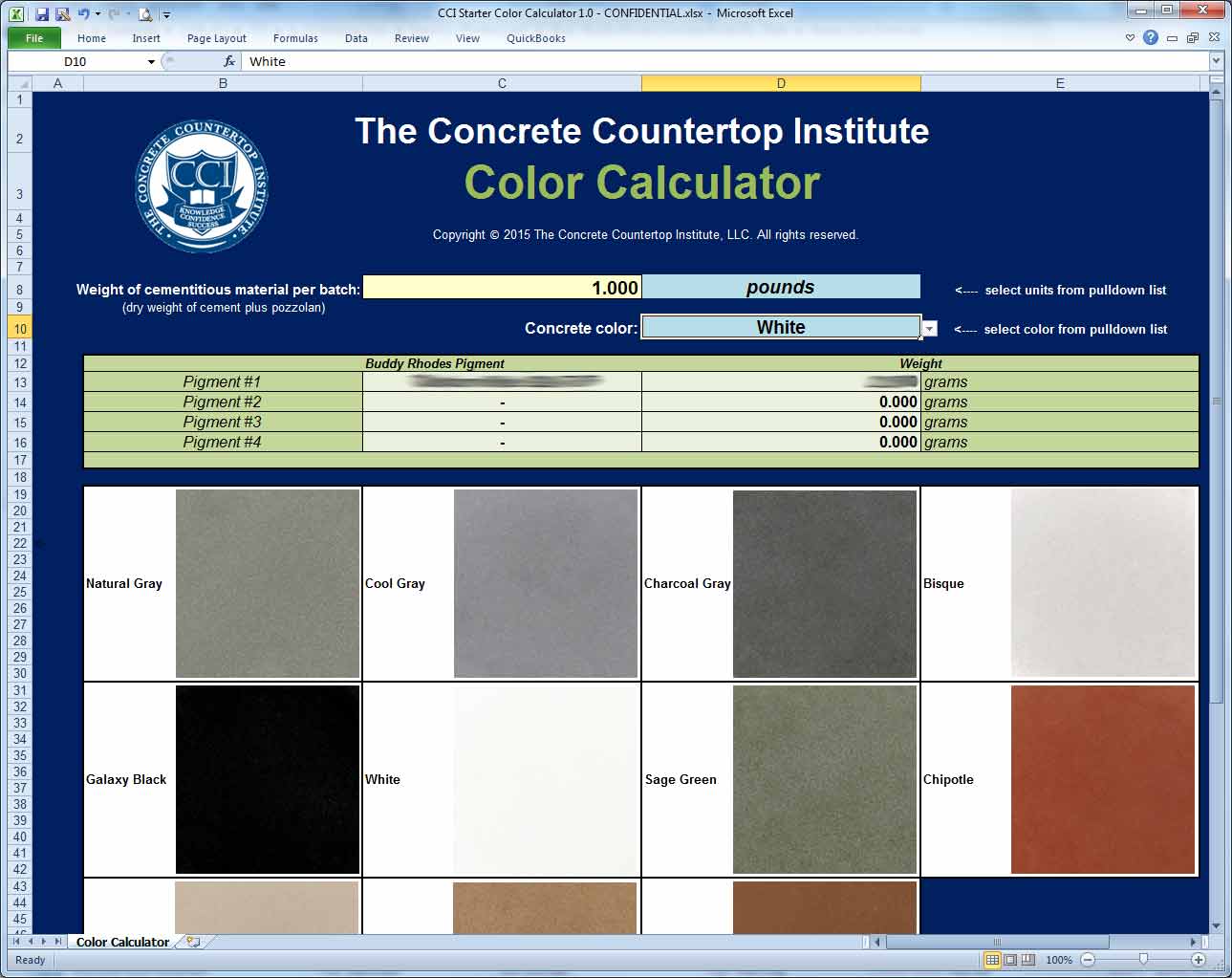Starter Color Formulas
$9.99


This extremely simple and easy to use calculator contains the color formulas for 13 popular earth tones, white, grays and black. Simply enter the weight of your cementitious content (cement plus pozzolans), and the calculator tells you exactly how much of each pigment to use, to the milligram.
All of the formulas are based on white cement, including Natural Gray! This makes it possible to have total precision and reproducibility of colors.
The calculator is a Microsoft Excel spreadsheet that is emailed to you upon purchase. Simply download the Excel file to your computer, and start making these popular colors.
This extremely simple and easy to use calculator contains the color formulas for 13 popular earth tones, white, grays and black. Simply enter the weight of your cementitious content (cement plus pozzolans), and the calculator tells you exactly how much of each pigment to use, to the milligram.
All of the formulas are based on white cement, including Natural Gray! This makes it possible to have total precision and reproducibility of colors.
The calculator is a Microsoft Excel spreadsheet that is emailed to you upon purchase. Simply download the Excel file to your computer, and start making these popular colors.
Q & A
 Starter Color Formulas
Starter Color Formulas
Here is an article that discusses the Use of Pozzolans in Concrete Countertop Mix Design
https://concretecountertopinstitute.com/free-training/the-use-of-pozzolans-in-concrete/
Hi Siddharth, and thank you for your interest in the Starter Color Formulas. The formulas are simply a suggestion for a starting point for developing a portfolio of 13 popular colors for concrete countertops. Even if someone had all of the exact pigments that we recommend in the calculator, when they made samples they would look slightly different than everyone else's samples made with the same pigments, due to the natural variations in sand and cement.
That said, the tricky thing for you will be that you can't get Buddy Rhodes Warm Gray and Cool Gray, which we use with white cement to make a consistent and convincing looking "Natural Gray". I recommend that you simply use gray cement to make your "Natural Gray" color, knowing that it might vary from time to time if your gray cement varies.
The other thing to be aware of is that colors are lighter and brighter when made with white cement, not gray cement, which is another reason we always use white cement. If you are unable to get white cement, you simply won't be able to make light, bright colors.
The color of your sand also affects the final color of your concrete. Try to get the whitest sand you can.
Here is a list of all of the pigments used in the Starter Color Formulas calculator in various proportions to make the 13 colors:
- Warm Gray and Cool Gray - Just use gray cement instead.
- Black Oxide, Red Oxide and Yellow Oxide - These are widely available from many manufacturers. (By the way, we also like to use Carbon Black with Black Oxide to create very black concrete. You should look for Carbon Black as well.)
- Titanium White - This also should be available from many manufacturers. It is used to boost the whiteness/brightness of any color, and in particular in white cement to make very white concrete.
- Sesame and Espresso - These are brown toned Buddy Rhodes colors. You could develop colors based on any 2 brown tones.
The calculator could still be useful for you as a general guide for developing a color portfolio, or you could simply experiment with the pigments you have to develop your own color portfolio.
I will say, natural gray is by far the most popular color for concrete countertops. About 80% of projects use it.
Reviews

5 star 100% 4 star 0% 3 star 0% 2 star 0% 1 star 0%







Helped me understand formula